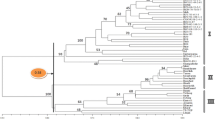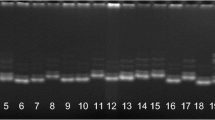Abstract.
Cultivated rice is a high-volume, low-value cereal crop providing staple food to more than 50% of the world populace. A small group of rice cultivars, traditionally produced on the Indo-Gangetic plains and popularly known as Basmati, have exquisite quality grain characteristics and are a prized commercial commodity. Efforts to improve the yield potential of Basmati have led to the development of several crossbred Basmati-like cultivars. In this study we have analysed the genetic diversity and interrelationships among 33 rice genotypes consisting of the traditional Basmati, improved Basmati-like genotypes developed in India and elsewhere, American long-grain rice and a few non-aromatic rice using a DNA marker-based approach – fluorescent-amplified fragment length polymorphism (f-AFLP). Using a set of nine primer-pairs we scored a total of 10,672 data points over all of the genotypes in the size range of 75–500 bp. The scored data points corresponded to a total of 501 AFLP markers (putative loci/genome landmarks) of which 327 markers (65%) were polymorphic. The f-AFLP marker data, which were analysed using different clustering algorithms and principal component analysis, indicate that: (1) considerable genetic variability exists in the analysed genotypes; (2) traditional Basmati cultivars could be distinctly separated from the crossbred Basmati-like genotypes as well as from the non-aromatic rice; (3) the crossbred Basmati-like cultivars from the subcontinent and elsewhere are genetically very distinct; (4) f-AFLP-based clustering, in general, conforms to the putative pedigree of the improved genotypes. Moreover, analysis to ascertain the scope of AFLP as a technique suggests that the polymorphism revealed by three selective primer-pair combinations is sufficient to obtain reliable estimates of genetic diversity for the type of material used in this study. However, its utility to identify group-specific DNA markers was discounted due to a low frequency of observed group-specific discrete markers.
Similar content being viewed by others
Author information
Authors and Affiliations
Additional information
Electronic Publication
Rights and permissions
About this article
Cite this article
Aggarwal, .R., Shenoy, .V., Ramadevi, .J. et al. Molecular characterization of some Indian Basmati and other elite rice genotypes using fluorescent-AFLP. Theor Appl Genet 105, 680–690 (2002). https://doi.org/10.1007/s00122-002-0973-6
Received:
Accepted:
Issue Date:
DOI: https://doi.org/10.1007/s00122-002-0973-6




